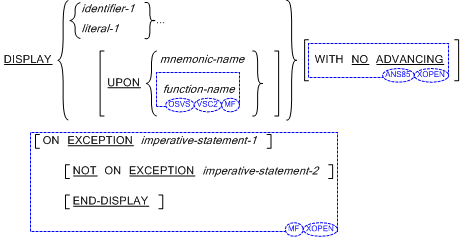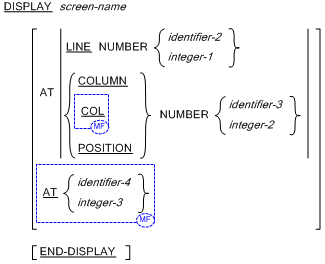The DISPLAY Statement
The DISPLAY statement also transfers data from your program to the CRT or video terminal screen: non-scrolling forms, into which you can enter data, are displayed.
General Formats for Format 1

General Formats for Format 2

General Formats for Format 3

Syntax Rules for Format 1
- The mnemonic-name must be associated with a function-name in the Special-Names paragraph in the Environment Division. See General Rule 9 in the topic The Special-Names Paragraph for a list of valid function-names.
- Alternatively, function-name can itself be used instead of an associated mnemonic-name.
- Each literal can be any figurative constant, except ALL.
- If the literal is numeric, it must be an unsigned integer.
This restriction can be ignored.
- When mnemonic-name is associated with ARGUMENT-NUMBER, then identifier-1 or literal-1 must each, if used, reference a data item defined as an unsigned integer or an unsigned integer literal respectively. Only a single identifier-1 or literal-1 can be used and the WITH NO ADVANCING phrase cannot be used.
- When mnemonic-name is associated with ENVIRONMENT-NAME or ENVIRONMENT-VALUE, then identifier-1, if used, must reference an alphanumeric data item or an object of type string. Literal-1, if used, must reference a nonnumeric literal. Only a single identifier-1 or literal-1 can be used and the WITH NO ADVANCING phrase cannot be used.
- The ON EXCEPTION and NOT ON EXCEPTION phrases can only be specified when mnemonic-name is associated with ENVIRONMENT-NAME or ENVIRONMENT-VALUE.
Syntax Rules for Format 2
- Screen-name cannot be an item with an OCCURS clause.
Syntax Rules for Format 2 and 3
- The LINE and COLUMN phrases can appear in any order.
- Integer-3 and identifier-4 must be 4 or 6 digits long.
Syntax Rules for Format 3
- A DISPLAY statement with an operand that is not a screen-name is treated as a Format 3 DISPLAY statement if it has an AT phrase, an UPON phrase with the CRT or CRT-UNDER option, a WITH phrase, or a MODE IS BLOCK phrase; or if it has no UPON phrase but the CONSOLE IS CRT clause is specified in the Special-Names paragraph. If it has the UPON phrase with the CONSOLE option, or if it has no UPON phrase and the CONSOLE IS CRT clause is not specified in the Special-Names paragraph, it is treated as a Format 1 DISPLAY statement.
- The phrases following the identifier can be in any order.
- Elementary data items in identifier-1 must be of USAGE DISPLAY.
- No elementary item in identifier-1 may be longer than 8191 bytes. If the MODE IS BLOCK phrase is used, the whole of identifier-1 must be no longer than 8191 bytes.
- If a DISPLAY verb is followed by more than one identifier-1, any WITH clause applies only to the operand immediately preceding it.
General Rules for Format 1
- When operands in a DISPLAY statement have USAGE other than DISPLAY, or have included signs, they are converted to USAGE DISPLAY with separate sign. The size of the operand is taken as the size after conversion.
- If a figurative constant is specified as one of the operands, only a single occurrence of the figurative constant is displayed.
- If the function-name COMMAND-LINE, or a mnemonic-name associated with the function-name COMMAND LINE, is specified, data
overwrites the contents of a system-dependent command-line buffer from where it can be retrieved by subsequent use of ACCEPT
FROM COMMAND-LINE. Only one operand is allowed in this case.
All permissible function-names other than those specifically mentioned in the general rules for Format 1 of the DISPLAY statement are treated as equivalent to CONSOLE and each operand is transferred to the console device in the order listed. The total size of data displayed is equal to the sum of the sizes of each operand. The display starts from the current cursor position, overflowing onto the following line(s) if necessary.
On earlier releases, trailing spaces after the last operand were not displayed.
- If the NO ADVANCING phrase is specified, the cursor is then left at the space following the last character displayed; otherwise it is positioned at the start of the next line. Scrolling can take place whenever the cursor is moved to a new line.
- If the mnemonic-name associated with the function-name ARGUMENT-NUMBER is used, then the position for any subsequent ACCEPT with a mnemonic associated with ARGUMENT-VALUE is set to retrieve the designated command-line argument. If the value associated with identifier-1 or literal-1 is less than 0, greater than 99, or greater than the total number of arguments on the command-line, then results are explicitly undefined.
- If the mnemonic-name associated with the function-name ENVIRONMENT-NAME is used then the variable to be read or set in any subsequent ACCEPT or DISPLAY with a mnemonic associated with ENVIRONMENT-VALUE is set to the designated variable-name specified in literal-1 or as the contents of identifier-1. The ON EXCEPTION phrase is ignored. If any problem occurs while trying to set an ENVIRONMENT-NAME for a subsequent ACCEPT or DISPLAY associated with ENVIRONMENT-VALUE, then it is only the subsequent ACCEPT or DISPLAY that must detect the ON EXCEPTION condition.
- If the mnemonic-name associated with the function-name ENVIRONMENT-VALUE is used then
- If a previous DISPLAY with a mnemonic-name associated with an ENVIRONMENT-NAME has been done, then the value of the identifier is placed into the designated environment variable.
- If no previous DISPLAY with a mnemonic-name associated with an ENVIRONMENT-NAME has been performed, or, for ACCEPT, if the specified environment variable does not exist, or, for DISPLAY, not enough space can be allocated to store the environment variable, the imperative statement associated with an ON EXCEPTION phrase is executed. The value in identifier is undefined in this case.
- If the mnemonic-name associated with the function-name SYSERR is used, then a DISPLAY is performed as if to the CONSOLE except that all output is directed to the system's standard Error Device.
- When using DISPLAY UPON ENVIRONMENT-VALUE, trailing spaces are included in the value. You should use INSPECT REPLACING ALL SPACE BY LOW-VALUES to avoid this.
- Within identifier-1, internal floating-point numbers are converted to external floating-point numbers for display, so that:
- A COMP-1 item is displayed as if it has an external floating-point PICTURE clause of -.9(8)E-99.
- A COMP-2 item is displayed as if it has an external floating-point PICTURE clause of -.9(18)E-99 (even though this picture string is illegal if explicitly specified).
- Literal-1 may be a floating-point literal.
General Rules for Format 2
- This format of the DISPLAY statement displays screen items, which are defined in the Screen Section of the program, and allows full access to the enhanced screen handling facilities.
General Rules for Format 2 and 3
- The AT phrase gives the absolute address on the screen where the DISPLAY operation is to start.
- The order of execution of a DISPLAY statement is always:
- The AT phrase
- The BLANK phrase
- The BELL phrase
- The DISPLAY operation
- If integer-3 or identifier-4 is 4 digits long, the first two digits specify the line, the second two the column. If 6 digits long, the first three digits specify the line, while the second three specify the column.
- Certain combinations of line and column numbers have special meanings, as follows:
- Until the column comes within range, out of range column values are reduced by the line length and the line value is incremented.
- Out of range line values cause the screen to scroll up one line. The effect is the same as if the line number of the bottom line had been specified.
- If the line and column numbers given are both zero, the DISPLAY starts at the position following that where the preceding Format 2 or Format 3 DISPLAY operation finished. Column 1 of each line is considered to follow the last column of the previous line.
- If the line number is zero, but a non-zero column number is specified, the DISPLAY starts at the specified column, on the line following that where the preceding Format 2 or 3 DISPLAY operation finished.
- If the column number is zero, but a non-zero line number is specified, the DISPLAY starts on the specified line, at the column following that where the preceding Format 2 or 3 DISPLAY operation finished.
General Rules for Format 3
- Part of this statement can be repeated to allow the display of several data items. If the first item has no AT phrase, it begins at line 1, column 1. Each subsequent item begins at the current cursor position as left after the previous item.
- If identifier-1 is a group item and no MODE IS BLOCK phrase exists, those elementary subordinate items which have names other than FILLER are displayed. They are displayed simultaneously, positioned on the screen in the order their descriptions appear in the Data Division, and separated by the lengths of the FILLER items in the group. For this purpose, the first position on a line is regarded as immediately following the last position on the previous line.
- The MODE IS BLOCK phrase indicates that the identifier is to be treated as an elementary item. Thus, even if it is a group item it is displayed as one item.
- The WITH phrase allows you to specify certain options available during the operation. (See
Screen Section Entry Skeleton for descriptions of these options.)
In addition to the options available as screen description clauses, the following options can be used in the WITH phrase; SPACE-FILL, ZERO-FILL, LEFT-JUSTIFY, RIGHT-JUSTIFY, TRAILING-SIGN and UPDATE. ZERO-FILL appears in this list and as a screen description clause because it has two different uses. Its second use is documented later in this chapter.
A configuration option is available which allows the entry of data into numeric and numeric edited screen fields in free format mode. In COBOL, nonedited numeric data items are intended for holding data in an internal form; however, this format enables such data items to appear on the screen. See your COBOL system documentation on user interfaces for more details. If free format mode is in effect, the data appears automatically reformatted as follows:
- With the virtual decimal point represented by a period
- With the sign represented by a sign character ("-" for minus; space for plus) which appears immediately before the leftmost digit
- With zero suppression in all integer character positions, except the least significant
- With left justification
The SPACE-FILL, ZERO-FILL, LEFT-JUSTIFY, RIGHT-JUSTIFY and TRAILING-SIGN options amend this format.
- If the literal-1 is one of the following figurative constants it has a special effect as follows: SPACE clears from the specified cursor position to the end of the screen; LOW-VALUE moves the cursor to the specified position; ALL X"01" clears from the specified cursor position to the end of the line; ALL X"02" clears the whole screen; ALL X"07" sounds the bell. If the literal is a figurative constant that is not listed above and the SIZE option is not specified, one occurrence of its value is displayed.
- If the SIZE option is specified for a figurative constant that has no special effect, then that figurative constant is displayed as many times as necessary to reach the length specified in the SIZE option. However, if the display wraps around to a new line, it starts again at the beginning of the figurative constant.
- When displaying to the screen, any previous foreground or background colors used at a particular screen position are inherited, unless you specify the FOREGROUND-COLOR and BACKGROUND-COLOR clauses again or use the BLANK SCREEN clause. The BLANK SCREEN clause clears the display, and any previous color settings are no longer inherited.
- If REDEFINES is used within identifier-1, the first description of the redefined data area is used and subsequent descriptions are ignored. If OCCURS or nested OCCURS are used the repeated data item is expanded into the full number of times it occurs, so that one definition is repeated for many fields.